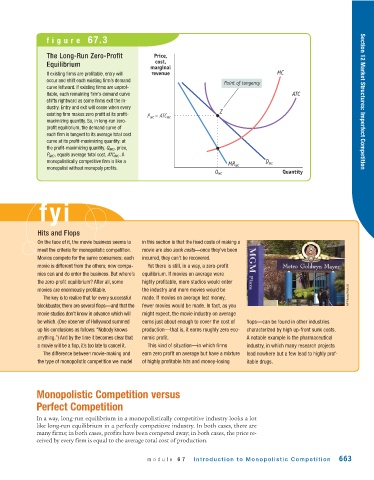Page 705 - Krugmans Economics for AP Text Book_Neat
P. 705
figure 67.3
The Long-Run Zero-Profit Price,
cost,
Equilibrium
marginal
If existing firms are profitable, entry will revenue MC
occur and shift each existing firm’s demand
Point of tangency
curve leftward. If existing firms are unprof-
itable, each remaining firm’s demand curve ATC
shifts rightward as some firms exit the in- Section 12 Market Structures: Imperfect Competition
dustry. Entry and exit will cease when every
Z
existing firm makes zero profit at its profit-
P MC = ATC MC
maximizing quantity. So, in long-run zero-
profit equilibrium, the demand curve of
each firm is tangent to its average total cost
curve at its profit-maximizing quantity: at
the profit-maximizing quantity, Q MC , price,
P MC , equals average total cost, ATC MC . A
monopolistically competitive firm is like a D
MR MC MC
monopolist without monopoly profits.
Q MC Quantity
fyi
Hits and Flops
On the face of it, the movie business seems to in this section is that the fixed costs of making a
meet the criteria for monopolistic competition. movie are also sunk costs—once they’ve been
Movies compete for the same consumers; each incurred, they can’t be recovered.
movie is different from the others; new compa- Yet there is still, in a way, a zero-profit
nies can and do enter the business. But where’s equilibrium. If movies on average were
the zero-profit equilibrium? After all, some highly profitable, more studios would enter
movies are enormously profitable. the industry and more movies would be
The key is to realize that for every successful made. If movies on average lost money, AP Photo/Nick Ut
blockbuster, there are several flops—and that the fewer movies would be made. In fact, as you
movie studios don’t know in advance which will might expect, the movie industry on average
be which. (One observer of Hollywood summed earns just about enough to cover the cost of flops—can be found in other industries
up his conclusions as follows: “Nobody knows production—that is, it earns roughly zero eco- characterized by high up-front sunk costs.
anything.”) And by the time it becomes clear that nomic profit. A notable example is the pharmaceutical
a movie will be a flop, it’s too late to cancel it. This kind of situation—in which firms industry, in which many research projects
The difference between movie-making and earn zero profit on average but have a mixture lead nowhere but a few lead to highly prof-
the type of monopolistic competition we model of highly profitable hits and money-losing itable drugs.
Monopolistic Competition versus
Perfect Competition
In a way, long-run equilibrium in a monopolistically competitive industry looks a lot
like long-run equilibrium in a perfectly competitive industry. In both cases, there are
many firms; in both cases, profits have been competed away; in both cases, the price re-
ceived by every firm is equal to the average total cost of production.
module 67 Introduction to Monopolistic Competition 663

